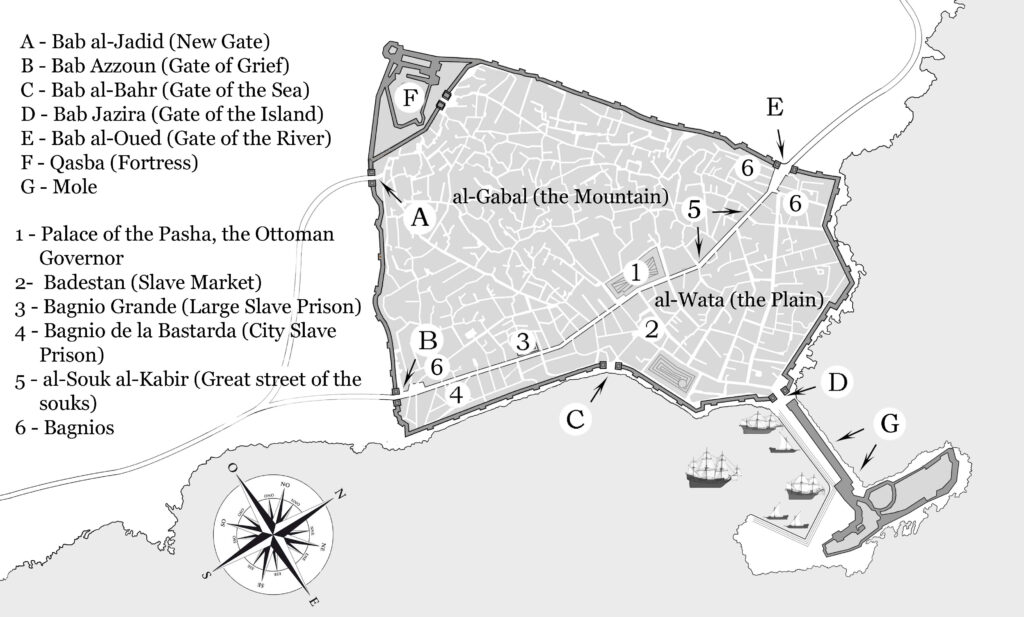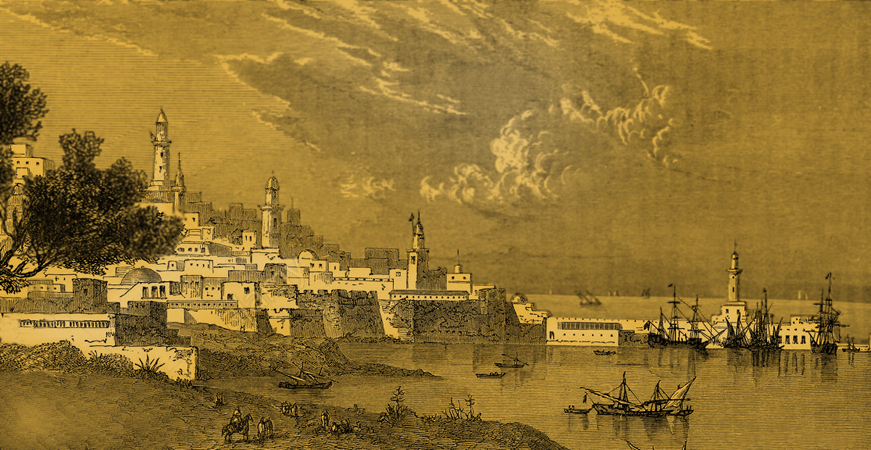Quite a few descriptions of Algiers penned by European observers have come down to us from the seventeenth century. One of the most interesting is that written by Reverend Ólafur Egilsson.
Reverend Ólafur was captured in July of 1627 on the island of Heimaey, one of the Westman Islands off the south coast of Iceland, by Barbary corsairs from Algiers. He, his young pregnant wife, and two of their children, along with nearly 250 other islanders, were herded aboard the corsair ships and taken to Algiers.
After a month-long sea voyage, the Icelanders found themselves on the block in the Badestan (the Algiers slave market; see the map of Algiers below for its location), being auctioned off to the highest bidder. Reverend Ólafur, however, wasn’t sold as a slave. He was in his sixties—too old to fetch a good price—and his captors packed him off to Copenhagen instead (Iceland was a Danish possession in those days) to negotiate ransoms for his family and the other Icelandic captives.
Upon his return to Iceland, Reverend Ólafur wrote a long narrative chronicling his experiences, in which he described the raid on Heimaey, the voyage to Algiers, Algiers itself, and his journey across Europe to Copenhagen.
What follows below is his description of Algiers. It is a rather eccentric description. He was only there for about a month all told—from the middle of August to the middle of September—and didn’t get to see all that much of the city, for he spent most of his time cooped up in the house of one of his captors.
So his isn’t a comprehensive description of the city. Rather, he describes what he saw in glimpses as he was being hauled through the streets from one house to another in the process of negotiating his release and subsequent voyage to Copenhagen. In a sense, it’s a series of snapshots—very interesting snapshots, for they provide details not found in other descriptions of Algiers of the time.
So here it is: Reverend Ólafur Egilsson’s description of Algiers as it was in August-September, 1627.
When we poor Icelandic people were put on land [in Algiers], such a huge crowd gathered that I think it was impossible to count their number. They did not come for any cruel purpose, but only to look at the poor captives. We Icelanders were separated from each other—friend from friend, children from their parents—and driven through the streets, from one house to another, to the marketplace, where we were put up for auction as if we were sheep or cattle.
The people who had been captured in East Iceland [in an earlier part of the corsair raid on Iceland] were first offered for sale, the men being kept separate in some houses, the women in other houses. This went on until the 28th of August, by which time most of the East Iceland people were sold.
After that, the people from the Westman Islands were brought to the marketplace [i.e., the Badestan; see the map of Algiers for its location], which was a square built up of stones with seats encompassing it all around. The ground was paved with stones which appeared glossy—which I understand is because they were washed every day, as were the main houses, sometimes as much as three times a day. This marketplace was next to where their local King [i.e., The Pasha, the Ottoman Governor of Algiers] had his seat, so that he would have the shortest way there, because, as I was told by those who had been there a long time (and were and are still Christians), their laws concerning the sharing out of captives were as follows.
First and foremost, the Captain got to have whichever two of the captives he wanted. Then their King (if I may call him that) took every eighth man, every eighth woman, every eighth boy, and then every eighth child. When he had taken these, the people who remained were divided into two groups, one for the ship owners and one for the pirates themselves.

We poor Westman Islands people were taken to the marketplace in groups, each of thirty. The Turks guarded each group in front and behind and counted heads at each street corner because the inhabitants of that place will steal such captive people if they get the chance.
When we came to the marketplace, we were placed in a circle, and everyone’s hands and face were inspected. Then the King chose from this group those whom he wanted, every eighth, as I mentioned earlier.
His first choice amongst the boys was my own poor son, eleven years old, whom I will never forget as long as I live because of the depth of his understanding and knowledge. When he was taken from me, I asked him in God’s name not to forsake his faith nor forget his catechism. He said with great grief, “I will not, my father! They can treat my body as they will, but my soul I shall keep for my good God.”
I have to say with Job: What is my strength, that I should hope? Were one to try to weigh my misery and suffering altogether on a scale, they would be heavier than all the sand in the sea.
The other Icelanders were moved from there to another place, and one of the Turks led two groups of ten around a stone column with loud screaming which I did not understand. I and my wife and our two younger children, a one-year-old and a one-month-old, were taken from that place up to the King’s hall [i.e., the Dar al-Soultan, the Pasha’s Palace; see the map of Algiers for its location], and there we sat with the children in our arms for two hours.
From there, we were then taken to the King’s prison [aka the Bagnio Grande; see the map of Algiers], where we spent that night.
From that time on, I do not know what became of the rest of the Icelandic people.
______
What I saw in that place of evil people is difficult for me to describe because I was so disoriented and grief-stricken at that time.
The first thing that we captives met on the streets when we came ashore were the donkeys, heavily laden. These animals are small by our standards, no bigger than a two-year-old mare, but they are very strong for carrying things. They have ears almost an ell long [an ell was about 21 inches/53 centimeters]. Their tails are thinner than horses’ tails, and their coats are patchy, like thin beards here and there. They walk with a feeding basket on their mouths, tethered by a string band slipped behind their ears, in which is the bread that they eat while walking. This goes on day after day.
I saw no wagons used for work in that place. There were many horses with feed baskets filled with bread. These horses were very thin. Most of them pulled the quern to grind meal.
In that town, I also saw five camels, which are strong and enormous. I could hardly reach up to their backs when they had their saddles on—which I think are normally kept on them. It is my opinion that each of these animals can carry as much as four or five horses. They are all pale or fawn-colored, with a dark stripe down their backs. In some ways they resemble cattle, especially about their legs and feet, which are cloven. They have a humped back, very long necks, and smallish ears almost like those of a horse. Their heads are very ugly, and they have lips like a bull’s. They also carry a feed basket of bread hung from their mouths. These animals are very slow. When they are whipped about their hind legs, they do not react in any way.
I also saw a dwarf man there and a dwarf woman, because they are so common in that town. He looked to me to be less than two ells tall, and she one and half ells tall. He had a short trunk and was long-legged with long arms reaching almost down to his knees. He was black as pitch with a big head. She was astonishingly fat, with short, fat legs and a long trunk. I also saw birds of many different types and colors and behaviors. And I saw a peacock and many other sorts of birds in an aviary.
For more of Reverend Ólafur Egilsson’s description of Algiers, see the next post here in this blog.

Corsairs and Captives
Narratives from the Age of the Barbary Pirates
View Amazon listing
The Travels of Reverend Ólafur Egilsson
The story of the Barbary corsair raid on Iceland in 1627
View Amazon listing